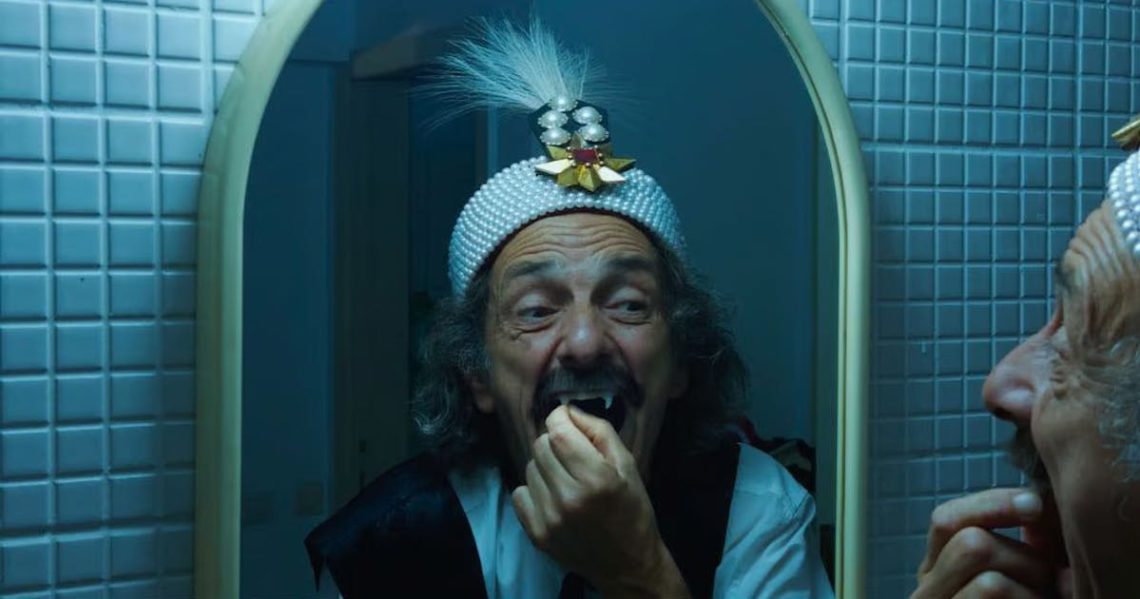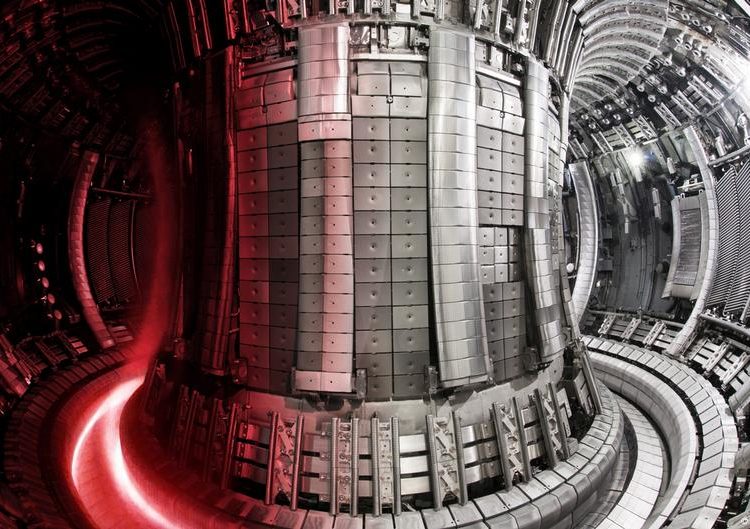There is, as anyone who has attended a film festival or repertory cinema screening of a classic foreign film can attest, a kind of laughter that pervades such dark spaces. It is a knowing laughter: signaling the recognition of a joke, more than an involuntary spasm of amusement that a joke might otherwise merit. Polite, and a little forced, it’s the golf-clap of guffaws. Radu Jude, the 40-something Romanian writer-director whose movies have, of late, become fixtures of the festival and art house circuits, does not elicit this kind of laughter. Vulgar, crass, and at times unbelievable, Jude’s films gin up laughs from deep in the guts. His movies are, in other words, actually funny.
In 2021’s Bad Luck Banging or Loony Porn, a hard-pressed high school history teacher fights off waves of moral scolds after a sex tape she made with her husband during the Covid-19 pandemic is accidentally uploaded to the web, where it goes viral. The film ends with our put-upon heroine transforming into a superhero and attacking her critics with a sex toy. Jude’s follow-up has another banger of a title. The 2023 black comedy Do Not Expect Too Much From the End of the World follows overworked corporate video producer Angela who moonlights as a monstrously sexist Andrew Tate–like “manosphere” influencer, using a Snapchat filter to mask her identity. With an exploitative, soul-crushing day job, Angela finds a bizarre outlet in the language and imagery of so-called “toxic masculinity.” Jude’s films are riven with such contradictions and deep absurdities. And as these brief descriptions likely make clear, he is obsessed with a world that has gone madder and madder as it has turned increasingly online.
This madness reaches an almost interminable frenzy with Dracula, one of two films the director released this year. This time, Jude returns to one of Romania’s foundational myths. The title may refer to the blood-sucking Count first appearing in the Irishman Bram Stoker’s 1897 novel. But Jude’s ostensible subject is Stoker’s inspiration: the ruthless Wallachian prince Vlad Tepes, a.k.a. Vlad the Impaler, a.k.a. Vlad Dracula. The historical Tepes is regarded in some quarters as a Romanian folk hero, for his fierce opposition to Ottoman invaders (“His cruelty,” a character in Jude’s film notes, “was born out of patriotic spirit!”). Dracula, meanwhile, has become one of the stock villains of the silver screen, a lecherous menace whose threat is diversely symbolically encoded across a range of artistic and academic interpretations. It’s another one of those knotty contradictions that sparks Jude’s imagination.
Dracula opens with a frustrated film director (Adonis Tanta) addressing the camera dead-on. He has been charged with mounting a “super-commercial” Dracula movie. No small task, considering the scores of extant adaptations, and variations. Stuck for inspiration, he turns to the most contemporary refuge for the constipated creative hack: AI. Through a series of prompts muttered into his tablet, the technology serves up about a dozen Dracula movies (and some entirely non-Dracula movies), many of which incorporate actual AI-generated imagery.
In one, Tepes returns to his childhood home and is galled to find it full of lollygagging tourists. An early segment sees Jude (or his creatively bankrupt filmmaker stand-in) abusing “fair use” copyright laws, by interrupting clips from F.W. Murnau’s formative film adaptation of Dracula, Nosferatu (1922), with annoying pop-up ads for online porn sites. An attempt to exploit “fair use” copyright laws to rework Francis Ford Coppola’s own kitschy 1992 adaptation proves even less successful. In one excruciatingly long chapter, a character modeled after Stoker’s hapless realtor-hero Jonathan Harker is consumed with proving that the vampiric presence in a village is actually an Orthodox priest.
Dracula is frustratingly critic-proof. Say that the AI effects look horrible and amateurish, and you’ll realize they’re meant to be.
In the best of the suite, Count Dracula works as a cruel taskmaster overseeing a tech firm devoted to “leveling up” video game characters for lazy American customers. He staves off a union drive mounted by disgruntled workers, aided by the ghosts of slaughtered factory workers, and a humanoid AI that looks like a crappy Halloween costume version of C-3PO from Star Wars. Another framing story involves actors in a sexed-up vaudeville version of Dracula escaping a mob of paying customers who seem intent on killing them, for real. In a particularly lewd digression, a peasant woman is repeatedly pleasured by a jack-hammering animated, hyper-vascular penis. This last one—which elicited, at least in this critic, a kind of sustained, Butt-Head-like chortling—comes as Dracula drags close to the three-hour mark. These interpolations are filigreed with garish, cartoonishly crass, and sexualized AI images of various Draculas, Vlads, and variegated vampires, bloodied lips, and other organs pulsing disgustingly.
Jude’s satirical use of AI points to the fundamental paradox, or problem, driving through the heart of his Dracula. It is frustratingly critic-proof. Say that the AI effects look horrible and amateurish, and you’ll realize they’re meant to be. The film is built to be revolting and annoying, verging in places on completely crazy-making. Jude’s characters (and perhaps large segments of his audience) find themselves reduced, like Count Dracula’s simpering sidekick Renfield, to cackling madly at the seemingly endless procession of batty, odious images and ideas. Any flaw is woven in as part of the fabric. Every bug is a feature. But to what end, exactly?
Generative AI in the arts has proven a big-time bugbear of late. From discussions around “ethical” AI to columnists salivating over the virginal quality of computer-generated “actress” Tilly Norwood (who, for the record, can be neither a virgin, nor an actress, because she is not real and does not exist), the technology is driven by a sense of inevitability. When a legacy director like George Miller (of Mad Max fame) says that “AI is here to stay,” he’s committing to an age-old fallacy of technological progress: the idea that each development in a technological process is a sort of natural development, being revealed, rather than invented. And until the AI bubble bursts (fingers crossed) and brings the American economy down with it (a prospect meriting less enthusiasm), such conversations and cultural convulsions are destined to get louder, stupider, and more strident.
Jude’s Dracula offers a valuable, if frustrating, intervention into this discourse. There are a great many film fans and practitioners who draw a hard line on AI. They believe it has no place in the seventh art, and that its uses should be identified and weeded out, with extreme prejudice. When IMAX and AMC Theatres announced that they were partnering with a generative AI software company to present an “AI Film Festival,” some cinephiles responded with calls for boycotts, and even jokey memes about suicide-bombing the cinema. (As someone who attended that festival—On assignment! I’ll add, defensively!—I can personally attest that it held little resembling actual artistic merit.) Such partisans maintain that the technology constitutes an inherent threat to the medium, and to the livelihoods of artists and technicians, and that it therefore, just as inherently, has no inherent value (or indeed, a negative value). Jude’s film has not escaped such criticisms. But again, one could argue, that that, too, is the point. It is an extended critique of AI, which also makes extensive use of it.Generative AI is itself vampiric. AI is a dead technology that lives only by sucking on the living artistic and creative labor of actual people.
After all, generative AI is itself vampiric. To paraphrase that oft-quoted Karl Marx line from Das Kapital, AI is a dead technology that lives only by sucking on the living artistic and creative labor of actual people. In its “training,” AI slurps down countless “datasets” of extant images, videos and texts, ripping off the handmade work of artists and skilled technicians to produce a pale approximation of the same. (Incidentally, Dracula’s cinematic adaptations have their own rich history of parasitism. Murnau’s Nosferatu, now rightly regarded as a horror movie classic, was born out of a different form of theft: It was an unlicensed adaptation of Stoker’s novel that the author’s estate attempted to sue out of existence, and it only survived thanks to the circulation of bootlegged film prints.) There is a kind of crude “master’s tools” argument for Dracula’s deploying of AI. But of course, we all know what they say about the master’s tools. It is even difficult to praise the film as some extended commentary on the vampiric influence of artificial intelligence on the creative arts. At one point a character cracks, “I don’t want any more of this vampire-equals-capitalism cliché.” At another, that same character remarks that the film, cobbled together from disparate parts, is more like Frankenstein’s monster than Count Dracula. (One imagines a defeated critic scribbling out such an observation in their notepad.) Dracula is so ironized and punishing that it becomes impossible to know which of its observations and criticisms we should even bother to take seriously. And this too is likely the writer-director’s M.O. The film lampoons not only Dracula adaptations, or generative AI technology, or the hypocrisies of a Romanian cultural and historical legacy built on a campaign of sadistic anti-Ottoman impalings. It satirizes the culture more broadly, where such disparate and distinct categories of observation and contemplation—pop culture, politics, history, religion—get reduced into a kind of icky morass; flattened, in internet terms, into mere “content.”
To fully crack Jude’s Dracula, it may make sense to look to the other film he made in 2025, and which toured the festival circuit in tandem. Kontinental ’25 is a sparser, more contained critique of a gentrifying European housing market (with the director’s usual digressions, of course) following a Romanian bailiff who struggles with tremendous guilt after a down-on-his-luck man commits suicide during eviction proceedings.
Shot on an iPhone in 10 days, immediately following the production in Dracula, and featuring many of the same actors, it is set in Cluj, the former capital of Transylvania (ancestral home of you-know-who), and its theme of gentrification begetting dispossession and death calls to mind the Count’s own diabolical schemes in the field of real estate speculation. But more than anything, Kontinental ’25 works almost as a reminder—to the audience, and perhaps to the filmmaker himself—that Jude can make a coherent, needling, realistic social satire, unburdened by both his usual irony, and by the distracting bells and whistles of generative AI graphics. It is an answer to Dracula’s original narrative prompt of a director stuck on good ideas, lazily petitioning AI for help.
To wit: Dracula itself ends not with some climactic scatological rhapsody, or maximalist expression of technological despair. It closes on a smaller, more sober vignette, about a sanitation worker who shows up to see his daughter perform at an elementary school concert, only to be shunned for appearing in his industrial uniform. The commentary on capitalism, and its capacity to sap the vigor of all those in its thrall, is as pointed as anything in any adaptation of Dracula, including Jude’s great many riffs. Unlike the parables that immediately precede it, however, it is intimate, non-obvious, AI-free, and so finely drawn as to elicit another reaction from the sensitive viewer: not a chortle or belly laugh, nor scoff of disbelief, but a whimper. Coming after 160-odd minutes of blood and boners, the effect is stabilizing, and a little humbling. It’s a proverbial stake through the heart that brings to mind the words of Bram Stoker, whose Mina Harker notes in her diary that a good cry “clears the air as other rain does.”
The post How Bad Is the AI Dracula Movie? appeared first on New Republic.




